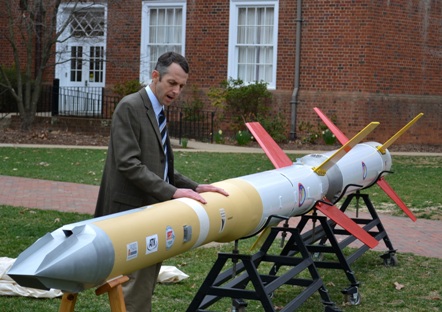The University of Virginia (UVA) is planning a 2012 launch of its Hy-V (high five) hypersonic engine demonstrator on a two-stage sounding rocket out of the NASA Wallops Flight Facility in Virginia.
After NASA-provided Terrier/Improved Orion solid rocket motors boost the payload to 70,000ft (21.3km) and 5.0M, solid fuel igniters on the two scramjet engines, one on each side of the nose cone, will initiate the 2.0M supersonic combustion of gaseous hydrogen for approximately 15sec in both engines. A cork-wrapped avionics package in the payload section of the sounding rocket will transmit scramjet temperature and pressure information to the ground through a band antenna. The engine will not be retrieved.
 |
|---|
©John Croft for FlightGlobal.com |
UVA's Chris Goyne describes the Hy-V experiment on 14 March |
Partners in the program include ATK for the scramjet engine, which includes the 2d nozzle, constant area isolator, combustion chamber and exit and Virginia Tech for the igniters. UVA is responsible for flow path elements and subsystem design as well as programme managment, largely using student resources.
Rather than generating thrust, the purpose of the scramjet is to flight validate similar test runs in a hypersonic wind tunnel with a 25 x 38mm (1 x 1.5in) test area the same shape and size as that of the flight experiment. The electrically heated wind tunnel at the UVA can simulate 5.0M conditions for several hours at time without the complicated effects of combustion-heated flow, a factor in hypersonic testing in larger wind tunnels.
The goal of the program is to develop test techniques for wind tunnels and for flight experiments to more accurately design and test scramjets, says UVA principal investigator Chris Goyne.
The video below shows Goyne discussing the project at a 14 March unveiling of a mockup of the vehicle at UVA.
Source: Flight International













